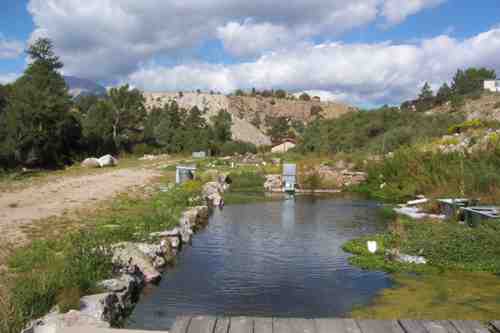Article by John Orr
Water – October 2008 – Colorado Central Magazine
Leadville Mine Drainage Tunnel
This past June — with the release of their LMDT risk assessment — Reclamation threw the Environmental Protection Agency under the bus over the possibility of a catastrophic blowout of water and debris. Readers may remember that a November 2007 letter from the EPA to Reclamation was the basis for the Lake County Commissioner’s local disaster declaration.
After the Reclamation report was issued, the EPA requested an assessment of the risk from the Army Corps of Engineers. In early September the EPA attached the Corps’ report to a letter to Reclamation. It said, “Based on USACE’s review, EPA believes that a catastrophic failure of the LMDT resulting in the rapid release of mine pool water and collapse debris is unlikely.”
So it seems that the disaster declaration, and resultant hit to Leadville’s economy, along with the considerable angst suffered by the residents of the East Fork trailer park was all for naught.
When the story broke nationwide, a Reclamation spokesperson told Colorado Central, “We want to know what has changed,” in the mine pool and up at the tunnel that led the EPA to issue such a dire warning. Reclamation had done a good deal of work in the tunnel to prevent a blowout and they had been monitoring conditions for years.
Earlier this year, representatives of the EPA said that the disaster declaration, “surprised us.”
In June Commissioner Mike Hickman was standing by the commissioners actions which were based on the EPA’s warnings.
It’s unclear whether anyone will take the time and effort to investigate the EPA letter, its authorship, and whether any engineering could back up their warnings. Now, they’ve backed off their position, and Reclamation says, “We appreciated the review that they and the U.S. Army Corps of Engineers did and found that there would be no catastrophic failure. We look forward to working with them and others on the long-term remedy for OU-6.”
It’s not easy to find a silver lining in all of this. But it looks like Reclamation and the EPA will get the funding necessary to complete the EPA’s preferred alternative for Operating Unit #6 in the California Gulch superfund site. Perhaps that was the original motivation behind the EPA’s November 2007 letter. Work on OU 6 had previously been stalled with little agreement between Colorado and the feds.
Colorado River Compact
In August John McCain — probably exhausted from campaigning — forgot that he was in Denver instead of Phoenix. He told The Pueblo Chieftain that the governors of the Colorado River Basin states needed to sit down and renegotiate the Colorado River Compact.
Here’s the quote, “I don’t think there’s any doubt the major, major issue is water and can be as important as oil. So the compact that is in effect, obviously, needs to be renegotiated over time amongst the interested parties.”
What was he thinking? Politicians and water officials across the state immediately jumped on his comments. U.S. Senate candidate Bob Schaffer and Senator Ken Salazar both talked about his comments in terms of a fight to the death. Opposition doesn’t get more spirited than that.
McCain immediately back-pedaled and sent a letter to Colorado Senator Wayne Allard saying that, “Let me be clear that I do not advocate renegotiation of the Compact.”
At the summer meeting of the Colorado Water Congress, Sara Duncan from Denver Water thanked McCain for uniting Coloradans.
U.S. Senate race
Former Republican congressman Bob Schaffer is challenging Democrat Mark Udall for Colorado’s open senate seat. The two candidates squared off in August at the Colorado Water Congress’s summer meeting and again in September at the annual Club 20 meeting.
During both debates Udall attempted to hang 2003’s Referendum A around Schaffer’s neck. The referendum would have set aside $2 billion for unspecified water projects around Colorado. The west slope called it a “water grab,” and it was subsequently defeated in all Colorado counties. Schaffer’s defense is that he is “a storage guy.” Udall said that the referendum was a stealth move to enable more transbasin diversions from the west slope — where there are still a few drops of undeveloped water — to the east slope.
A big differentiator between the two is Schaffer’s promise to stand against the feds if they try to claim Colorado water for endangered species or environmental reasons. This position puts him in the traditional mode of “water conservationist,” that is, conservation in its old-fashioned sense, which means putting every drop to work for beneficial use.
Schaffer points out that Udall was an original sponsor of the Clean Water Restoration Act of 2007. In January, at the Colorado Water Congress’s winter meeting, Thomas Donelly, from the National Water Resources Association, said that the bill, “Removes the nexus between navigable and jurisdictional waters,” and will encompass any land that, “was wet, is wet or will be wet in the future.” Udall has since pulled his sponsorship after hearing from farmers and home builders.
An area where there is a fairly large disagreement between the two candidates is over oil shale development. Udall favors going slow, evaluating the environmental impacts and technology carefully, while focusing on water requirements. Schaffer thinks that leasing should proceed quickly along with rule setting so that energy companies know what the rules are up front.
Since we live in the age of the Internet you can see both candidates answer questions in a YouTube debate. As we go to press the URL for the video is:
http://www.youtube.com/youchoose08.
Amendment 52
Amendment 52 is an attempt to share some of the state’s oil and gas severance tax revenue to improve Interstate 70 through Colorado. The amendment would add $225 million to transportation improvements over four years but that would be at the expense of water improvement projects and other programs.
In September Club 20 reversed their position and decided to oppose the amendment, citing the reduction in dough for water projects. Small towns all over the state are struggling with infrastructure needs and tighter standards. Club 20 also mentioned that the focus was on just I-70 and that it didn’t want another fiscal constraint in the state constitution.
Short takes
* Supreme Court Chief Justice Mary Mullarkey has added the Water Court Committee as a permanent standing committee. The committee grew out of the work of a committee charged with streamlining water courts.
* In August the Upper Arkansas River Water Conservancy District scored $296,000 for satellite telemetry equipment to help monitor reservoir levels and stream flow to facilitate exchanges.
* In September the Colorado Supreme Court heard arguments on Summit County’s cyanide heap leaching ban. Officials in Gunnison, Conejos, Costilla and Gilpin counties are watching closely as they have also banned the process. The only heap leaching operation in the state is in Teller County.

* Salida, Nestlé and the Upper Ark District are working on leveraging the Upper Ark’s augmentation plan, along with Salida’s extra Arkansas River water, to replace the water the bottler plans to truck from the Hagen spring to Denver.


